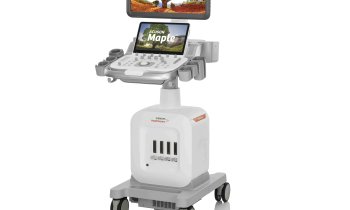Research in computed tomography is currently focused on using dual energy (DE) to distinguish between different tissues on CT images. While other manufacturers are trying to generate different energies with a single X-ray tube, Siemens launched the Somatom Definition already four years ago - a Dual Source CT scanner with two X-ray tubes that simultaneously work with two different radiation energies. A great variety of information about the type and composition of the tissue and the perfusion of an organ can be derived from a data record acquired with a single scan for which several examination steps or procedures had been necessary in the past. The dual energy procedure spares
the patient several scans, accelerates clinical workflows and opens up new clinical fields of application for computed tomography. One of the new dual energy applications for the Somatom Definition from Siemens is syngo DE Heart PBV (Perfusion Blood Volume), which provides color-marking of nonperfused
parts of the myocardium during cardiological examinations. Moreover, a specific
application enables the isolated display of the heart, for example without thorax
structures. The heart perfusion is examined primarily after an infarction to determine damaged areas of the organ. DECT for the first time allows to detect a stenosis and the stenosis degree as well as the location and extent of the resulting reduced perfusion in the myocardium in a single scan. Deposits of uric acid crystals in the joints of gout patients may damage the cartilaginous and osseous substance, particularly if the disease has been chronical for several years. With syngo DE Gout, computed tomography can for the first time be used also for gout detection. The new DE application assists the physician in clearly identifying uric acid crystals in the extremities and monitoring changes in the crystals in the course of treatment.
Syngo DE Lung Vessels provides a whole series of new applications to assist the
physician in CT examinations of patients with suspected pulmonary embolism – a sudden occlusion of blood vessels in the lungs. The new applications enable the detection of nonperfused blood vessels and tissue of the lungs through color-marking. The application "Lung Isolation" isolates the entire organ to allow the assessment of the perfusion situation without obstructing neighboring organs.
Syngo DE Brain Hemorrhage assists in the distinction between new and old hemorrhages in the event of cerebral bleeding. The two energy levels of the X-ray tubes are used to fade out the contrast medium (CM). In the past, this had required two scans.
The CM subtraction offers two advantages: A non-CM enhanced examination is not necessary and the patient is spared the dose of a second scan. The four new DE applications presented by Siemens at the ECR 2008 supplement the six already existing CT applications with dual energy features:
- syngo DE Direct Angio for the distinction of bone and vessel structures, particularly
- if the vessels are located immediately next to the bone
- syngo DE Lung PBV for perfusion assessment of the lung tissue
- syngo DE Muskuloskeletal for the display of ligaments and tendons
- syngo DE Calculi Characterization for the automatic distinction of the biochemical composition of renal calculi, e.g. uric acid or calcium oxalate
- syngo DE Hardplaque for the display of calcification in the body and determination of the vessel status
- syngo DE Virtual Unenhanced for the subtraction of contrast medium in abdominal scans











